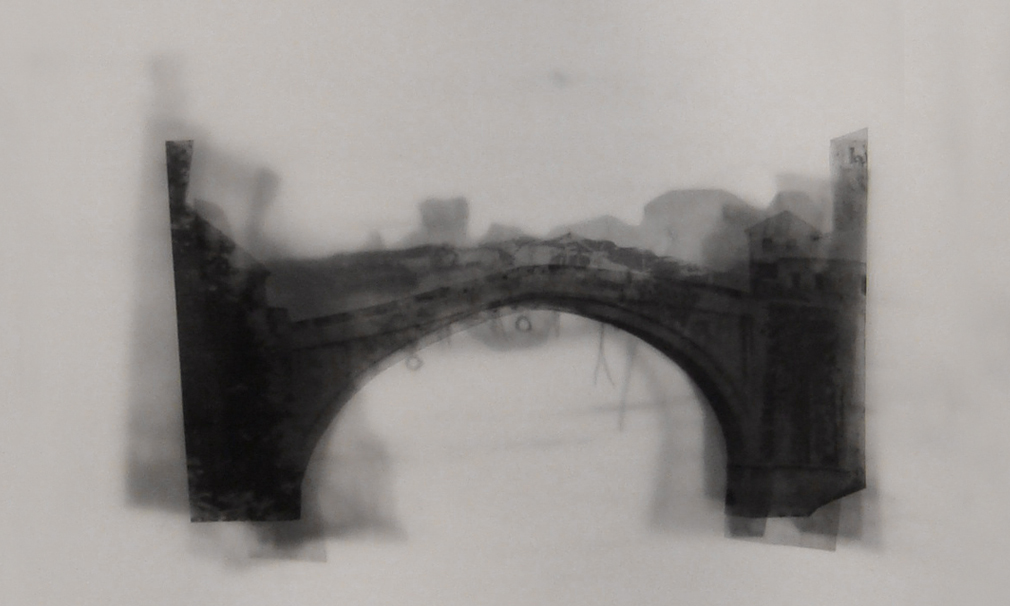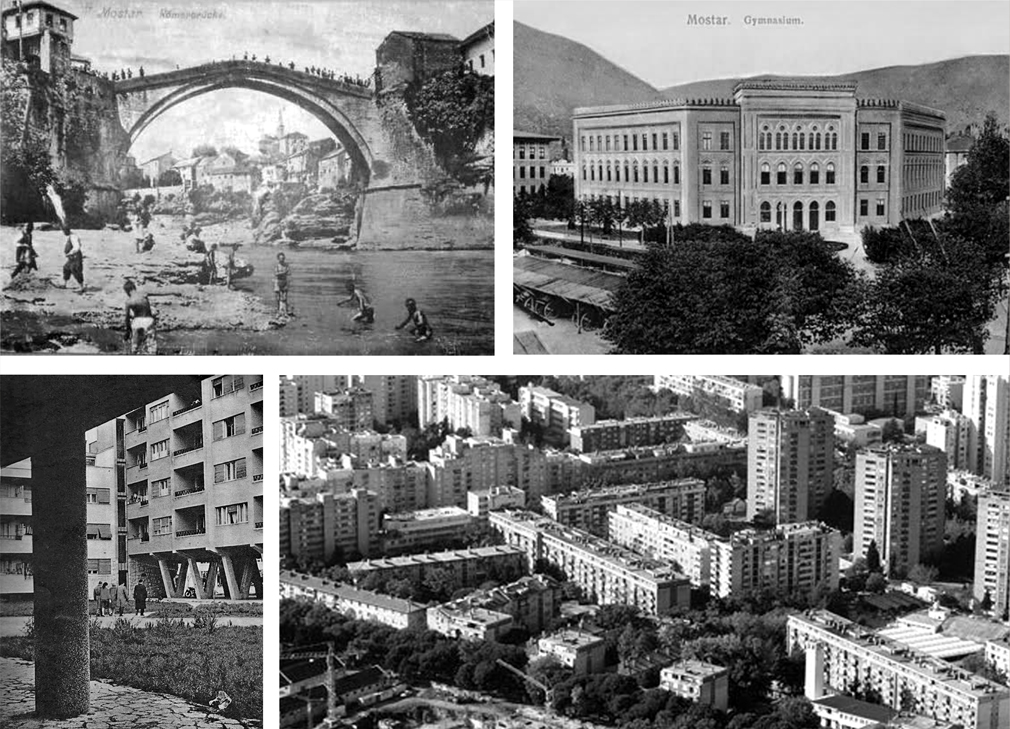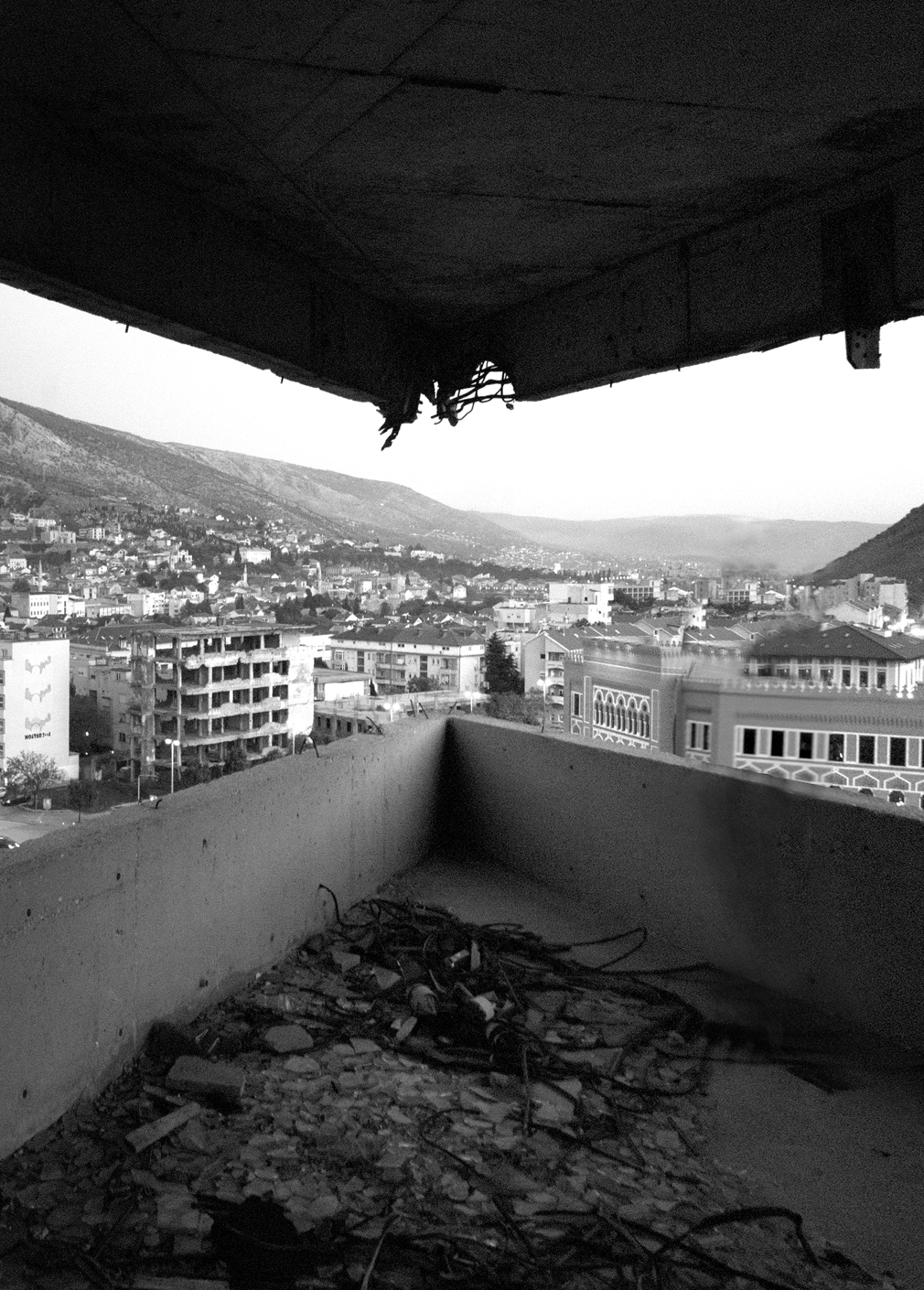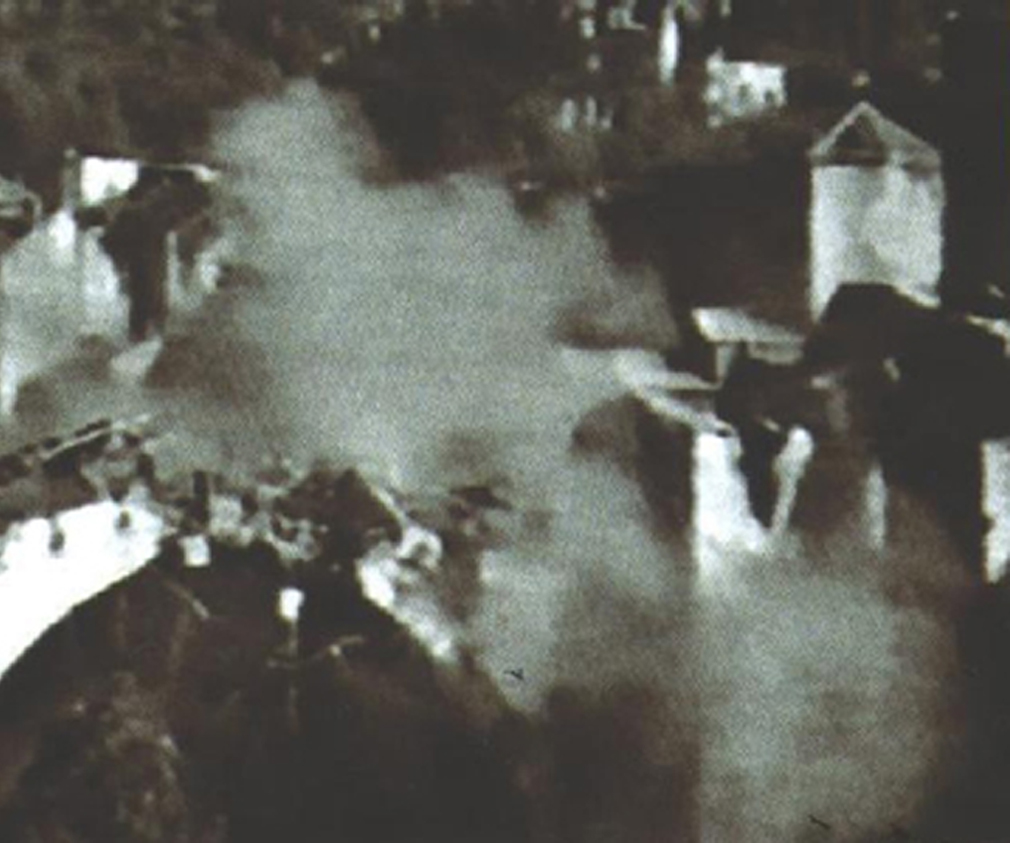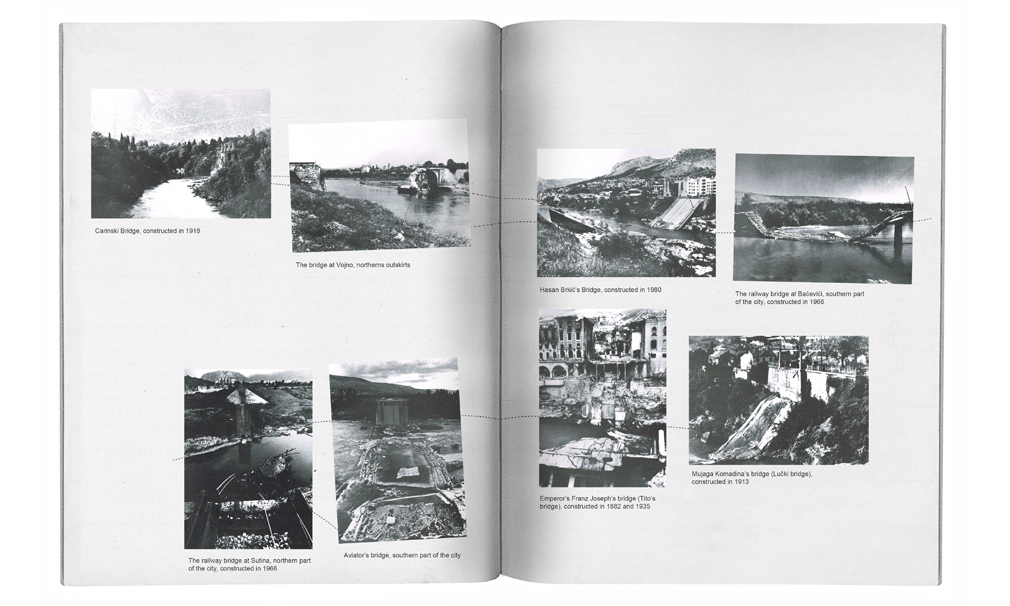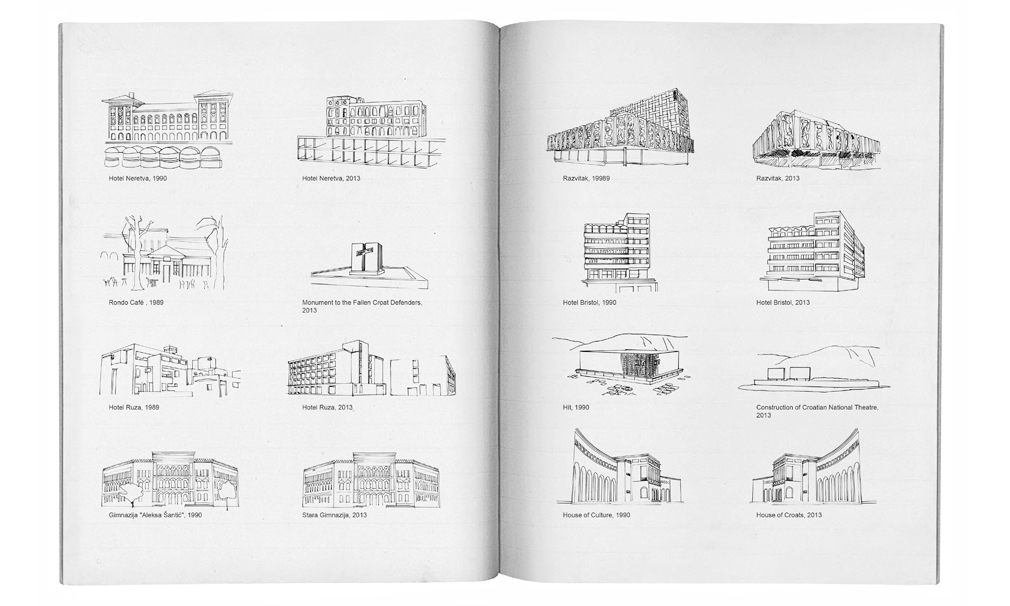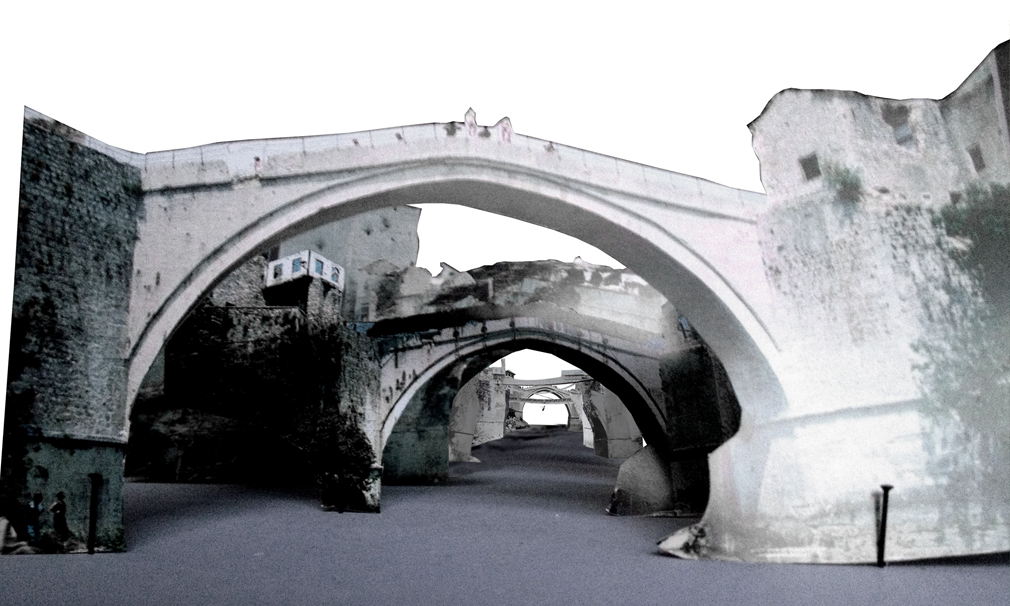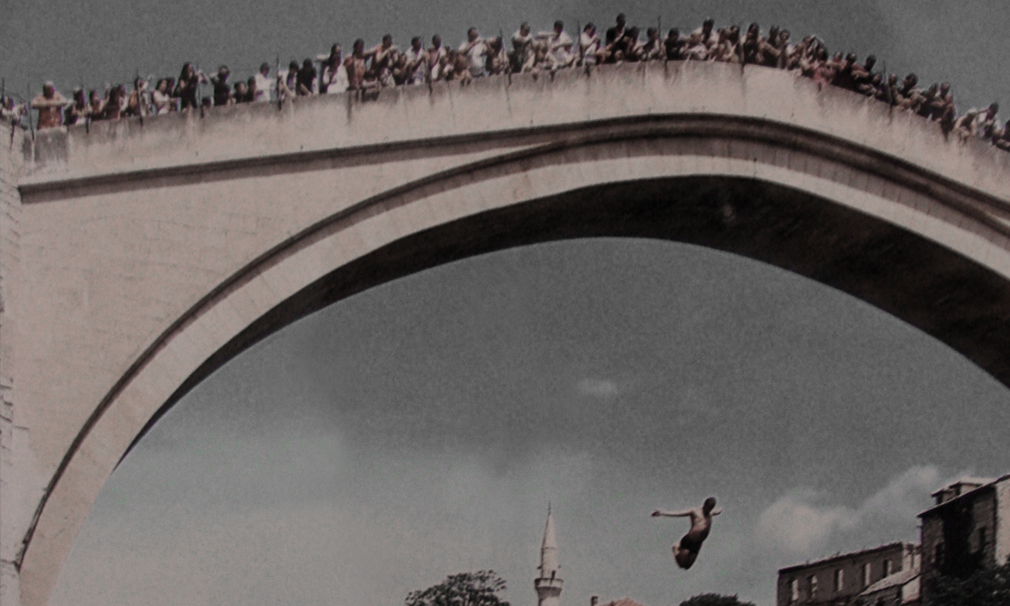As a follow up to the article ‘Mortal Cities and Forgotten Monuments‘ about the role of the monuments commemorating the victims of fascism in former Yugoslavia, this article will focus on the role architecture has played during the war in Bosnia-Herzegovina (1992 – 1995), focusing specifically on the city of Mostar, partially due to its personal significance. In September 1993, in the midst of the civil war, I fled Bosnia-Herzegovina together with my parents. In the summer of 1999, we came back to visit the country. That summer, and many more after it, we visited cities like Sarajevo and Mostar. Full of wonder I studied the demolished cities and buildings. It was, and still is, a unique experience to visit a city in such a condition.
Architecture has a strong influence on people’s feelings. Every one of us has buildings, streets or squares in our environment to which we are, consciously or unconsciously, very much attached. Oftentimes we presume that the city we live in will always be there. We presume the office we work at, the school building we are taught in, the supermarket we do our shopping at and the building we live in will never disappear. We also presume that the monuments that have been a part of the cities we live in for centuries will never be gone. We can imagine that we, as city dwellers, will move to a different city, or that certain buildings will have different functions or might be replaced by new ones; however, it is hard to image that we could lose our cities and that a large part of the buildings in the city could disappear or turn to ruins. Since these principles are common to most city dwellers, people are hit particularly hard when cities get destroyed. This is exactly what happened in Mostar: not a single inhabitant would have thought that 70 percent of their city would get annihilated and that only a spectre of what their city once was would remain.
Mostar is exemplary for the situation of Bosnia-Herzegovina. It used to be the paragon of tolerance and was known as the city which had the most mixed marriages of former Yugoslavia. Founded in the 13th century, the city has a rich Ottoman, Austrian-Hungarian and Yugoslavian history that used to be legible in the form of architecture. Thanks to the river Neretva, which runs through the city, Mostar served as a trade city for those who traveled from the Adriatic Sea to the Balkan midlands.
Mostar got its name from the bridgekeepers, mostari, who watched from their towers who would enter the city via the bridge (most means ‘bridge’ in the Serbo-Croatian language) crossing the Neretva. During the last civil war this city, along with its inhabitants, had much to suffer. From all the cities in former Yugoslavia Mostar was the most destroyed city during the war.
Mostar was destroyed and divided in the course of two separate battles during the 1992-1995 war in Bosnia-Hercegovina. This war, which officially began in Sarajevo in April 1992 and officially ended with the signing of the Dayton Agreement in December 1995, was the third in a series of wars that resulted in the break-up of the Socialist Federal Republic of Yugoslavia. The first siege of Mostar took place in the spring of 1992 when the city was surrounded and shelled by Bosnian Serb paramilitaries and the Army of the Republika Srpska (VRS) and with support from the Yugoslav People’s Army (JNA). Their heavy artillery attack lasted for 3 months and was successfully defended by the Mostar Battalion of the newly formed and poorly equipped Army of Bosnia-Hercegovina as well as by the Bosnian Croat militia known as the HVO. The second major siege of the city began in May 1993. This time, the city was attacked by the HVO, having military and financial support from the Croatian Army. The HVO first cleansed the western part of the city of non-Croats. Most Muslims and the few remaining Serbs fled to the already severely damaged eastern part of Mostar, which the HVO then began shelling from previously secured positions in the hills around the city. The wartime physical and demographic change was the most visible and dramatic difference after the war; however, the psychological and political division of the city into a Muslim controlled and populated “east Mostar” and a Croat controlled and populated “west Mostar” proved a much deeper and persistent legacy.
40,000 people had left the city by 1995 and a sixth of the inhabitants had taken refuge abroad. 70 percent of all buildings were heavily or entirely destroyed. The city was left divided: one part where the Bosnian Croats were in charge, with the other part controlled by the Bosnian Muslims. Each area has its own schools, fire department, hospital, football team, bus station and cellular network. Besides these dominant ethnic identities, there are other groups who live in Mostar, including those who consider themselves belonging to neither of these groups, and others from mixed marriages who don’t count themselves to one specific group. These people are spread over both parts of the city.
Part of the war in Bosnia-Herzegovina was a war against the architecture of the city. This argument is made due to the fact that rather than demolishing any arbitrary building, specific symbolic architecture – buildings with which the inhabitants identified themselves and their culture – was targeted. Think of important cultural heritage, such as libraries, museums, universities and squares. By destroying such buildings, not only a history and culture of a city get destroyed, but also the awareness begins to emerge that the city is mortal. This is exactly what happened in Mostar. The destruction did not just impact the citizens as large parts of the city were destroyed, but more so because it specifically destroyed symbolic places. This is a well-known war tactic: psychologically disable people by destroying everything they can identify themselves with, causing people to lose hope, get emotionally paralyzed and lose their ability to fight back.
In his book The Destruction of Memory, Robert Bevan explains the logic behind a war against architecture: “Here architecture takes on a totemic quality: a mosque, for example, is not simply a mosque; it represents to its enemies the presence of a community marked for erasure. A library or art gallery is a cache of historical memory, evidence that a given community’s presence extends into the past and legitimizing it in the present and on into the future. In these circumstances structures and places with certain meanings are selected for oblivion with deliberate intent. This is not ‘collateral damage’. This is the active and often systematic destruction of particular building types or architectural traditions that happens in conflicts where the erasure of memories, history and identity attached to architecture and place – enforced forgetting – is the goal itself. These buildings are attacked not because they are in the path of a military objective: to their destroyers they are the objective.”
In The Book of Laughter and Forgetting, Milan Kundera describes how this kind of warfare works: “The first step in liquidating a people is to erase its memory. Destroy its books, its culture, its history. Then you have somebody write new books, manufacture a new culture, invent a new history. Before long the nation will begin to forget what it is and what is was.”
But it went even further than that, as Bevan notes: “The notorious Serbian police chief in Serb-occupied Prijedor, (…) was proud of his work, which is reported to have included deciding who was sent to the Omarska concentration camp. He told one reporter: ‘With their mosques, you must not just break the minarets. You’ve got to shake up the foundations because that means they cannot built another. Do that, and they’ll want to go. They’ll just leave by themselves. The rationale as part of ethnic cleansing is clear: remove the Muslims themselves and destroy identifiably Muslim secular and religious buildings; bulldoze the remains and clear graveyards; seize identity papers and burn cadastral records.”
By destroying symbolic architecture that carries cultural identities, both the history and the present of the people gets denied and erased. It is only logical that one would lose all hope by this. But losing hope is the most dangerous condition in which a city can find itself. The process of one of Yugoslavia’s most famous architects, Bogdan Bogdanovíc, losing all of his hope is recounted by Chris Keulemans in his book Van de Zomer naar de Werkelijkheid (‘From Summer to Reality’):
“Bogdanovíc never believed that eternal cities would descend from the heavens, but that it’s a human characteristic to, amidst the rubble and debris, listen to his memories and build a new city modelled after the old one. Bogdanovíc says: ‘We all carry, even now, our eternal city within ourselves – if only because we do not know another way to structure the world around us’”.
In 1947 the young architect Bogdanovíc flew over the heavily bombarded Karlsruhe. From the twin-engined Douglas he saw how beautifully the city streets ran from the central square, like sunrays. People on the street wandered amid the ruins and the heaps of grit, but from the sky he could see the city square lay undamaged, en he knew that Karlsruhe would rebuild itself. Underneath the debris lay the memory of the original city undamaged. In that time, just after the Second World War, he visited destroyed cities like Rotterdam, Coventry and Dresden. He saw signs of hope. The remains of the past architecture, its talisman, formed the basis for its reconstruction.
Maybe Bogdanovíc changed, or maybe the war did, but nowadays the old professor cannot see the signs anymore. Now he considers the fate of his precious cities as murder instead of destruction. He is not able to think about their reconstruction anymore. He cannot imagine that people would still want to live at the scene of such a crime. His book on the architecture of memory was about to be printed, in the late autumn of 1993, when the news of the destruction of the old bridge in Mostar reached him. He collapsed and lay in bed with high fever for two days. After that he wrote an epilogue for his book. With the loss of the bridge, ‘the replica of the heavenly rainbow’, the city was robbed of its connection with the dome over the earth. And with that, he feared, its death was sealed. ‘My question … I don’t know to whom, I don’t know what answer I expect … my question is as follows: will the cities to which I was connected by hundreds of visible and invisible ties, whose beauty I have admired, the cities of so many of my friends – will Vukovar, Sarajevo, Mostar in the topography of their ashes ever find a sign of hope, the hidden scripture of the Eternal Recurrence? Will they even know the desire to live again?”
During the first war of Mostar in 1992 an incredible amount of cultural heritage got deliberately destroyed in just two months. Mostar ’92 Urbicid documented this very well: “All the bridges have been destroyed except the Old Bridge; out of 14 town mosques only two remained undamaged. The Catholic church at Potoci village, the Franciscan church in Mostar, the Episcopical Residence, the monastery of the Franciscan sisters at Bijelo Polje have been burnt, the cathedral of Mostar shelled. The Palace of Culture, the museum, the archives and the library have been damaged. All of the Mostar hotels, schools, dormitories and colleges have been ruined. The town beauty, the hotel “Neretva” is on fire. The “town houses” are ablaze: the bath, the court, the Town Hall, the cadaster.”
And this was only the beginning. During the second siege, the destruction resumed. The more that got destroyed, the harder it got for the inhabitants to recognize the city that was engraved in their memory. In the end they stopped caring, as long as the Old Bridge would remain. It was the symbol of the city–the symbol of the connection between the two parts of the city; the symbol of tolerance and unity. The city was the bridge, and the bridge was the city. It served as both the symbol of the city and as a public space where people got together. It was a meeting place; for generations it was a spot where couples would plan their first date and where the famous annual diving competitions were held. The attack of this bridge would be an attack at the concept of multi-ethnicity. When the bridge would be gone, Mostar too would cease to exist, and the soul of the city would disappear. This is exactly what happened. When the bridge was destroyed, the city seemed to have taken its last breath. The city turned out to be mortal; the city was dead.
It is fascinating to think that architecture, in this case a bridge, can mean so much for the inhabitants of a city. In The Destruction of Memory Robert Bevan explores this phenomenon and writes: “’Why do we feel more pain looking at the image of the destroyed bridge than the image of massacred people?’ Asked the Croatian writer Slavenka Drakulić at the time: Perhaps because we see our own mortality in the collapse of the bridge. We expect people to die; we count on our own lives to end. The destruction of a monument to civilization is something else. The bridge in all its beauty and grace was built to outlive us; it was an attempt to grasp eternity. It transcends our individual destiny. A dead woman is one of us – but the bridge is all of us forever.”
Mostar 92 Urbicid contains a quote of Džemal Čelić explaining that the demolition of all the bridges in Mostar has another, even bigger consequence: “Studying the old bridges we shall experience and understand the whole history of our country where bridges appear as road signs of positive movements of culture and civilization in any span of the times passed. Therefore we cannot accept their destruction in the latest war as a result of strategic necessity, but as a violence against the identity of our peoples.”
The Old Bridge was not only an important symbol for the city of Mostar and for the whole country, but most of all an important public space. Lots of other public spaces have deliberately been destroyed, such as the monument designed by Bogdanović commemorating the Partizans who died in WW II, café Rondo, Hotel Neretva, the Bistol Hotel, the Ruža Hotel, the Razvitak and Hit department stores, the high school and the Palace of Culture. Every single one of these were meaningful public places that made Mostar a vivid, tolerant city where it did not matter what your religion or ethnicity was. One was simply a Mostarac or Mostarka.
Each of these meaningful buildings has got a different future. The monument built by Bogdanović was rebuilt and subsequently became the target of heavy vandalism. The ruins of café Rondo have been replaced by a monument for the Croatian defenders. Hotel Neretva and the Razvitak department stores still lie in ruins. The Bristol Hotel, the high school and the Palace of Culture have been rebuilt exactly as they were – even though the Palace of Culture got its name changed into the Palace of Croatians – and the ruin of the Ruža Hotel is currently being rebuilt.
In 2004 the Old Bridge (which has been listed within UNESCO World Heritage), finally looked as it did in 1566. For the construction of the New Old Bridge, the decision was made to quarry stone from the same mountain as centuries ago, and it was rebuilt using the same technique as then; however, the bridge turned out whiter and smoother than the Mostarci and Mostarke remembered. Some old pieces of the original bridge now lie at the pebble beach and serve as places to sit.
The opening of the bridge in 2004 made world news: “In searing heat of more than 40C this afternoon, princes, presidents and prime ministers from all over Europe and the Middle East are to attend the opening of the “new Old Bridge” whose restoration is being hailed as the start of a happier new era for Mostar.” There was a big celebration; trained divers dove off the bridge with torches. The bridge became a national and international showpiece that needed to show it had succeeded in once again unifying the two different ethnic groups of Mostar. If this could be possible in Mostar – the city with the most complex political situation of all – it could be possible in all of Bosnia-Herzegovina. On the UNESCO website, it reads that “the reconstructed old bridge and old city of Mostar are symbols of reconciliation, international collaboration and the peaceful coexistence of different cultural, ethnical and religious communities”.
I wish that UNESCO’s optimism were justified, but the actual situation in the city goes completely against the above statement. And although it is very good that the Old Bridge has been rebuilt – many of the inhabitants were very proud at the opening ceremony and it was an event that had Bosnia make the international news in a positive way – the New Old Bridge nonetheless has a different meaning. It just is not the same bridge to the current and former dwellers of Mostar–both physically and mentally—because Mostar still remains a divided city. As long as the inhabitants live their lives separated, the original function and meaning of the bridge will never return. Its original function was simple: to get from one side of the city to the other. This is something that nowadays is mainly done by tourists. The original meaning has vanished as well: a public space where people got together; not just a physical but also a mental connection between the two sides of the river.
An important question is the one Bogdan Bogdanović iterated after the demolition of the Old Bridge: “This leads us to the inevitable question whether we understand what the irreversible disappearing of a city brings about. If the city is an unsurpassed storage of memories, one that surpasses the memories of a nation, race, language by far, what will be the consequences of that disappearance?”
The Old Bridge is no longer a connection, but now rather a separation of the city. The city used to be all about connection, even its name derived from it. With the loss of this connection, the city has disappeared. This has not just to do with the destruction of buildings – buildings can be rebuilt. More important is the citizens’ identification with these buildings. It is about building on the cultural history of the city. Building on this history cannot be done by ignoring the war or acting like the war never happened. In what way a city like Mostar will restore itself is unclear. What we can be sure of, is that the city will never keep on being itself, but will rather transform into a totally different society. The inhabitants of the city have a big responsibility. Hopefully the inhabitants – who share something unique: the image of destruction – will contribute to the building of this new society. It is to be hoped that religion and ethnicity will one day not play a role anymore and that the schools, fire departments, cellular networks, hospitals, football teams and bus stations will be reduced by half: one for both parts of the city.

